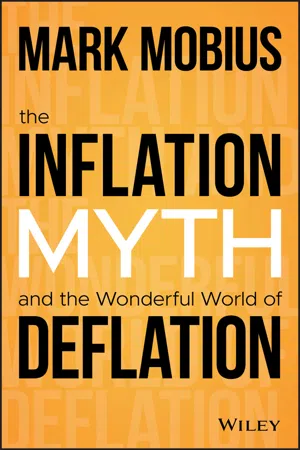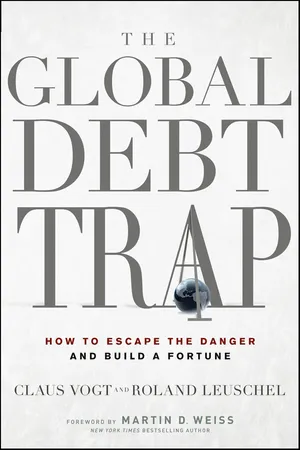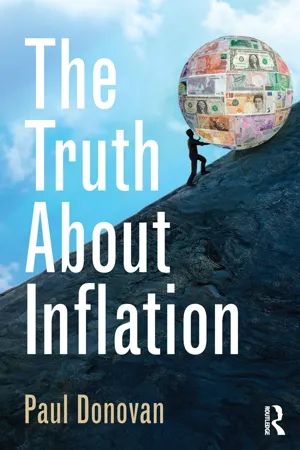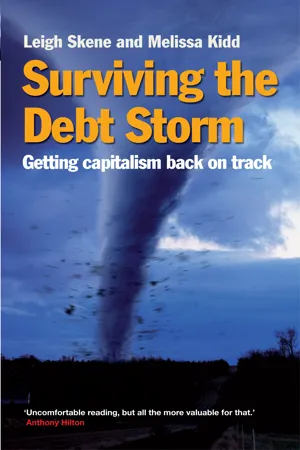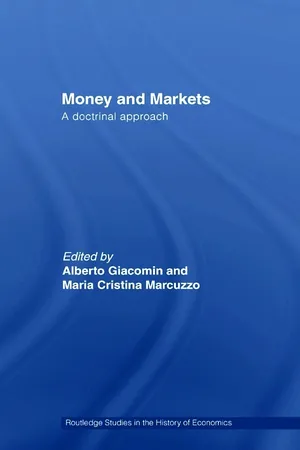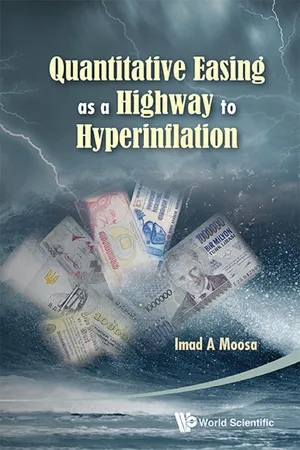Economics
Debt Deflation
Debt deflation refers to a situation where the overall level of prices in the economy falls, leading to an increase in the real burden of outstanding debt. This can result in a downward spiral as falling prices lead to lower incomes and asset values, making it harder for debtors to repay their debts, which in turn can further depress economic activity.
Written by Perlego with AI-assistance
11 Key excerpts on "Debt Deflation"
- Mark Mobius(Author)
- 2020(Publication Date)
- Wiley(Publisher)
“The basic prescription for preventing deflation is straightforward, at least in principle: Use monetary and fiscal policy as needed to support aggregate spending, in a manner as nearly consistent as possible with full utilization of economic resources and low and stable inflation. In other words, the best way to get out of trouble is not to get into it in the first place.”35Deflation Benefits Debtholders and Property Owners
*Michael Hudson, Wall Street financial analyst: “When there's deflation, it means that although most markets are shrinking, and people have less to spend, the 1% that hold the 99% in debt are getting all the growth in wealth and income. Deflation means that income is being transferred to the 1%, that is, to the creditors and property owners.”64Technology Is Causing Deflation
*Ken Moelis, founder of Moelis & Company: “A big secular thing going on is technology and deflation. This is where I think millennials are getting that it is an improvement in life, and they're taking advantage of it.”65*Jim Grant, founder of Grant's Interest Rate Observer: “Thanks to the spread of electricity and other such wonders in the final quarter of the 19th century, prices dwindled year by year at a rate of 1.5% to 2% per year. People didn't call it deflation – they called it progress.”66Deflation Is Bad for People in Debt
*Michael Hudson, Wall Street financial analyst: “There are two definitions of deflation. Most people think of it simply as prices going down. But Debt Deflation is what happens when people have to spend more and more of their income to carry the debts that they've run up – to pay their mortgage debt, to pay the credit card debt, to pay student loans.”64*Ben Bernanke, former chairman of the US Federal Reserve: “Deflation can be particularly dangerous when a financial system is shaky, with household and corporate balance sheets in poor shape and banks undercapitalized and heavily burdened with bad loans.”34Deflation is a Decrease in Money Supply and Credit
*Mish Shedlock, investment advisor representative for Sitka Pacific Capital Management: “Deflation properly defined is a net decrease in the money supply and credit, with credit being marked to market. Deflation by that measure went global long ago.”67*Murray N. Rothbard, economist, historian, and political theorist: “‘Deflation' is usually defined as generally falling prices, yet it can also be defined as a decline in the money supply which, of course, will also tend to lower prices. It is particularly important to distinguish between changes in prices or the money supply that arise from voluntary changes in people's values or actions on the free market; as against deliberate changes in the money supply imposed by governmental coercion.”- eBook - ePub
Fear and Greed
Investment risks and opportunities in a turbulent world
- Nicolas Sarkis(Author)
- 2012(Publication Date)
- Harriman House(Publisher)
These various choices are not mutually exclusive. As an economy grows naturally, some inflation usually occurs too, thus shrinking the debt in two ways simultaneously. There will also likely be some shrinkage of the debt from defaults and restructurings even if growth and inflation are in evidence. However, deleveraging periods are usually dominated by one of these three forces in particular.The optimal outcome is if the economy experiences genuine growth in order to ease its debt-burden. This can be a tall order in cases where debt is especially heavy, as the research of Reinhart and Rogoff has so ably demonstrated. In cases of heavy indebtedness, the natural tendency is often towards a deflationary collapse. The classic example of this was the Great Depression of the 1930s.Shortly after the 1929 to 1932 meltdown, Irving Fisher explained a deflationary debt-collapse in terms of a chain of consequences. First, investors seek to pay off debt en masse , resulting in distress-selling. In turn, this leads to shrinking bank credit and a falling stock of money. Prices then fall, squeezing profits and the value of assets. Trade contracts and businesses lay off workers, leading to lower confidence all round and money-hoarding. As prices fall, interest costs effectively rise.The science of economics has become more sophisticated since Fisher’s time, but his basic message still resonates. “It is always economically possible to stop or prevent such a depression simply by reflating the price level up to the average level at which outstanding debts were contracted by existing debtors and assumed by existing creditors, and then maintaining that level unchanged,” he wrote.[21]This logic has inspired the money-printing or quantitative easing exercises that central banks in the West have pursued in response to the latest crisis.Deleveraging through inflation
Although quantitative easing is not a new idea, the scale of these efforts over recent years has been unprecedented. Between 2008 and 2011, America’s Federal Reserve created more than $2 trillion out of thin air, which it has used in order to buy up US government bonds and other assets, and thereby pump money into the financial system. The Bank of England (BoE) was even more zealous in its approach, such that it owned an astonishing one-third of the total UK government bonds in issue as of early 2012. - eBook - ePub
The Coming Bond Market Collapse
How to Survive the Demise of the U.S. Debt Market
- Michael G. Pento(Author)
- 2013(Publication Date)
- Wiley(Publisher)
stable means not easily moved. However, to the men and women who control our money supply, it means increasing about 2 percent a year. So determined are they that the economy not be met by the evil deflationary monster that they create inflation of 2 percent (as measured by the phoniest of inflation measurements known as the Personal Consumption Expenditure Price Index). This is done as a buffer or wall to block evil deflation from coming in—because once that evil deflation monster enters the economy, they fear he will never leave.The word deflation is a little nebulous in that it is used by economists in a technical way to describe a decline in the money supply. Most laypeople view deflation as a generalized decline in prices. Inflation , in turn, would refer to an increase in prices or, more technically speaking, an increase in the money supply or the fear of such a future increase in its supply that causes a decline in the purchasing power of the currency.As a follow-up to my introduction on decreasing prices, I have decided to start my critique of Fed myths with the Keynesian Fed-lore of the “deflationary death spiral”; this Fed-lore is very widely held and promulgated. The men and women at the Federal Reserve believe that a slight increase in prices is a sign of a growing economy and falling prices are devastating.Let’s put this Keynesian Fed-lore to the test and see how it holds up.In an economic environment of increasing productivity accompanied by a static money supply, one would assume that prices would slightly decrease. As an industry becomes more productive and makes better use of technology, those technological advances aid in the reduction of costs associated with producing the product. Profit margins improve, and in a competitive environment, businesses will pass most of these savings on to consumers. So with truly stable prices, the costs of many items would go down, and that would be a positive result; it would indicate that businesses were leveraging productivity to increase profit margins and decreasing the price of goods to consumers. However, outside of technology, we rarely see this materialize.Those at the Fed view any deflation as harmful, regardless of the cause. Ben Bernanke has said that “deflation is in almost all cases a side effect of a collapse in aggregate demand—a drop in spending so severe that producers must cut prices on an ongoing basis in order to find buyers.”1 - eBook - ePub
The Global Debt Trap
How to Escape the Danger and Build a Fortune
- Claus Vogt, Roland Leuschel, Martin D. Weiss(Authors)
- 2010(Publication Date)
- Wiley(Publisher)
CHAPTER 4 The Road to (Hyper)InflationWill the bursting of the real estate bubble lead to a deflationary endgame? Or will the printers of money with their so-called rescue packages and unaffordable economic stimulus programs prevail, producing rampant inflation? That is the decisive question for investment success over the coming years. So it behooves you to become familiar with the arguments behind both scenarios, and this, in turn, is not possible without clearly defining the terms.Today, the terms inflation and deflation are generally used to refer to a rise or decline in price levels measured by a basket of consumer goods. Although technically accurate, the problem with this definition should be clear: it describes only one of many symptoms—namely price changes in a basket of goods that can be manipulated at will. However, the underlying cause of these price changes remains—intentionally—unclear. Plus, the composition of the consumer basket, along with the methods for measuring their price changes, leave an extremely broad latitude for generating politically desired results.In contrast, the classic definition of the terms inflation and deflation, which has now largely fallen into disuse, begins not with the symptoms but with the cause. Inflation (deflation) is an increase (decrease) in the supply of money and credit .Let’s first explore the latter. The Deflationary ScenarioThe direct consequence of speculative bubbles that burst is, of course, none other than a price collapse in the object of that speculation. If these are contained in the consumer basket, and if they cheapen the basket overall, then economists who base their definition on consumer prices will speak of deflation.Bursting speculative bubbles also are deflationary in classical definition: they lead to an increase in the demand for cash and a decrease in the supply of money and credit. Cash and equivalent—including cash in circulation, federal funds, money market funds, and other short-term instruments—are viewed as havens in times of great uncertainty in the financial markets, and they are thus in greater demand. - eBook - ePub
- Robert W. Dimand(Author)
- 2019(Publication Date)
- Palgrave Macmillan(Publisher)
upon Franklin Roosevelt , without mention of debt-deflation or of Minsky’s references to Fisher (the phrase “Debt Deflation” appears on page 227, without Fisher’s name).The Experience of the 1920s and 1930s
The experience of the 1920–1921 deflation and recession helped shape analysis of the Great Depression . Britain began a contractionary monetary policy to raise the pound sterling from its 1920 low of $3.20 towards its pre-war parity of $4.86 (which was finally reached in 1925), even though the United States was itself undergoing a sharp deflation at the time. A. W. Phillips (1958 , p. 115) records that in the United Kingdom unemployment rose from 2.6% in 1920 to 17.0% in 1921 and 14.3% in 1922, while wage rates declined by 22.2% in 1921 and 19.1% in 1922, and the cost of living index fell by 12.8% in 1921 (“largely a result of falling import prices”) and 17.5% in 1922, substantially less than the decline in money wage rates in those years. Phillips was concerned to explain changes in wage rates by unemployment and cost of living changes. From the point of view of Fisher (1926 ), concerned with explaining unemployment , these figures suggest that the unemployment of this period cannot be blamed on downward rigidity of either money or real wages. Rapid wage deflation did not eliminate British unemployment in the early 1920s, contrary to what the analysis of Edwin Cannan (1932 , 1933 ) and Robbins (1934 ) would have predicted. This experience was also inconsistent with the argument in Keynes’s General Theory (1936 , Ch. 2) that real wages are countercyclical, a claim that Keynes (1939 ) abandoned in the face of evidence advanced by John Dunlop (1938 ), Michal Kalecki (1939 ), and Lorie Tarshis (1938 , 1939 ). Because the 1921 drop in the cost of living largely reflected lower import prices (as the exchange value of sterling rose), the decline in the product wage (the real wage cost to firms) would have exceeded the decline in the purchasing power of money wages. The 1921–1922 British experience of high unemployment and falling real wages recurred in many countries in the Depression: real weekly earnings in manufacturing in 1932 were 15% lower than in 1929 in Germany, 14% lower in the United States (Temin 1989 - eBook - ePub
- Paul Donovan(Author)
- 2015(Publication Date)
- Routledge(Publisher)
9 The debt–inflation mythAnnual income twenty pounds, annual expenditure nineteen six, result happiness. Annual income twenty pounds, annual expenditure twenty pounds ought and six, result misery.(Wilkins Micawber in David Copperfield by Charles Dickens)So far, the chapters of this book have discussed inflation generally in the context of economics, and how that might influence investors. This is only right. Economics should take its proper place of pre-eminence in the natural order of things. This chapter differs somewhat from the preceding chapters. This chapter covers the role of inflation and debt, and this is a topic in which economics and investing are intimately bound up together. The economics of debt relies on investors, because debt requires credit, and creditors are investors.The perceived relationship of debt and inflation is the greatest misconception that surrounds inflation. Time and time again an economist will hear ‘governments will inflate their way out of debt’ being asserted with a complete certainty as to the belief that inflation will automatically reduce a government’s debt burden. This is just not true. The idea that inflation automatically reduces government debt is the great debt–inflation myth that has been sold to credulous investors for decades.In most circumstances in twenty-first century financial markets inflation will tend to either maintain or increase a modern government’s debt, both in absolute terms and relative to GDP over the longer term. The debt–inflation myth is wrong but the myth has been extrapolated, moving from the specific case of government debt to be applied more widely to corporate or to consumer debt where there is generally even less justification for the assertion. In the wake of the significant increase in government debt levels and the persistence of consumer and corporate debt levels in some economies in the aftermath of the global financial crisis, this is an increasingly important topic for investors to understand. - eBook - ePub
Surviving the Debt Storm
Getting capitalism back on track
- Leigh Skene, Melissa Kidd(Authors)
- 2013(Publication Date)
- Profile Books(Publisher)
8Deflation is not a four-letter word
The classical definitions of inflation and deflation rates referred specifically to changes in money supplies, not prices. Central banks redefined inflation and deflation rates as the calculated average price changes in the prices of the output of goods and services, which gives governments and central banks four benefits. First, it diverts attention away from their continuous inflation of money supplies. Second, it lets them change the way of calculating inflation from time to time to lower the observed rate and further hide their war on savers with low interest rates and the growth in money supplies.Third, it exempts asset prices from the definition of inflation. The public like rising asset prices, so central banks can print all the money they want as long as it flows mainly into raising asset prices. Indeed, printing money is the reason housing prices (read the cost of shelter) have risen faster than output costs. Rising shelter costs eroded living standards so much that, unlike the balance of history, one breadwinner per family has been insufficient for the past four decades.Fourth, concentrating on output prices allows governments and central banks to be disingenuous when discussing the effects of inflation and deflation. They frequently point out that inflation favours debtors, asset markets and financial intermediaries, but never point out that deflation benefits savers and the productive part of the economy. Endlessly evoking images of the Great Depression has almost convinced consumers (who crowd into closing-down, end-of-season and Boxing Day sales) that low prices are bad.By contrast, focusing on the vast majority (75% or more) of people who have enjoyed rising real incomes in periods of deflation would give an entirely different impression. Similarly, Western governments and central banks continuously harp on about Japan’s ‘lost decades’. Japanese financial institutions and speculators did lose heavily, but the general public became much better off as unemployment remained low relative to the rest of the world and the prices of everything from rent to golf course memberships fell and became affordable again. Western governments, central banks and bankers label deflation ‘bad’ and praise the virtues of a modest amount of inflation. - eBook - ePub
- Steven Horwitz(Author)
- 2000(Publication Date)
- Routledge(Publisher)
less than its specie holdings. Presumably any depositor of specie will want a receipt for that amount and that receipt serves as money. In addition, a bank that acquired specie on its own and then decided not to monetize it by lending it out would be sacrificing the interest earnings necessary to compensate for the cost of obtaining the specie. By ruling out absolute losses in specie from the definition of deflation, Rothbard can only see deflation as occurring after an inflation.In much of his discussion of the effects of inflation, Rothbard covers the standard Austrian ground of relative price effects, debtor-creditor redistributions, and the business cycle. He also recognizes that inflation is fundamentally a redistributive process. So much so that he is led to say that there is ‘no social utility in an increased supply, nor any social disutility in a decreased supply, of money. This is true for the transition period [between monetary equilibria] as well’ (1962:711).20 This is worded very carefully to leave open the possibility that inflation causes a decrease in utility and deflation an increase therein, but his emphasis is surely on the redistributive processes at work in both inflation and deflation. The nuances of that quote aside, in analyzing the effects of inflation, he is largely on target. What is interesting, but not surprising, is the dearth of attention paid to deflation. In the 30-page section where he discusses the effects of inflation (as an instance of ‘the economics of violent intervention in the market’), his discussion of deflation is less than two full pages. It occurs in the sub-section on ‘Secondary Developments of the Business Cycle’ and is mostly laudatory concerning the ways in which deflation is necessary to undo the effects of the necessarily prior inflation. Even the redistributive aspect of deflation is praised because it ‘takes away from the original coerced gainers [from inflation] and benefits the original coerced losers’ (1962:865). In addition, deflation can, by definition, never go farther than bringing the money supply down to equal the supply of specie, thereby doing the desirable deed of eradicating the inflation.21 - eBook - ePub
- Maria Cristina Marcuzzo, Alberto Giacomin(Authors)
- 2007(Publication Date)
- Routledge(Publisher)
as such. Thus a special section on deflation-induced stagnation in Japan has been inserted in latest-vintage textbooks (see, e.g., Blanchard 2003), while retaining the idea that under normal conditions falling money wages and prices, far from being harmful to the economy, cause it to move down along a well-behaved AD function.2 ‘By the Keynes-effect I mean the hypothesis, granted by Keynes, that an increase in the supply of money, measured in stable purchasing power and caused by falling prices, reduces the rate of interest and thereby favourably influences the volume of investment’ (Haberler 1958: 491, fn. 3).3 It may be observed, en passant, that – although Fisher’s analysis is conducted on the basis of the quantity theory of money – the fall in prices can be conceived of as the consequence of nothing but the ‘distress selling’ of products aimed at raising the money required to pay off debt, thus making reference to the quantity theory of money unnecessary.4 As pointed out in Keynes (1931), the fall in the price of assets, which takes place as a part of the general process of deflation, is also liable to cause serious embarrassment of the banks, with negative repercussions on their lending policy.5 In the preparatory notes for The Monetary Theory of Production – this being the original title of what was to become The General Theory of Employment, Interest and Money – Keynes makes the point that Marx was right in pointing out that ‘the nature of production in the actual world is not, as economists seem often to suppose, a case of C-M-C', i.e. of exchanging commodity (or effort) for money in order to obtain another commodity (or effort). That may be the standpoint of the private consumer. But this is not the attitude of business, which is a case of M-C-M' - Imad A Moosa(Author)
- 2013(Publication Date)
- WSPC(Publisher)
There is also the concept of “biflation” (also called “mixflation”), which is a state of the economy where the processes of inflation and deflation occur simultaneously. Under biflation, the prices of commodity/earnings-based assets rise while the prices of debt-based assets fall. Biflation occurs because a greater amount of money is allocated to the purchase of essential items, away from buying non-essential items. It can also be seen in terms of the prices of essential items (food, energy, etc.) and luxury items such as top-end cars and other typically debt-based assets. Unlike stagflation, there is no reference in the definition of biflation to the state of the economy. The concept has emerged as a result of the debate the world economy as a whole is facing inflation or deflation (the fire or ice debate).Nouriel Roubini has coined the term “stag-deflation”, where a recession is associated with deflationary forces (Roubini, 2008). In 2008, Roubini predicted that the U.S. economy was heading towards stag-deflation for four main reasons: (i) a slack in goods markets, (ii) a re-coupling of the rest of the world with the U.S. recession, (iii) a slack in labor markets, and (iv) a sharp fall in commodity prices. He concluded that the conditions prevailing then “would reduce inflationary forces and lead to deflationary forces in the global economy”. The main theme of this book is that hyperinflation is more likely than deflation.1.6.Concluding RemarksThis chapter is about some preliminary clarifications pertaining to the concept of inflation and many related concepts. Simulated data were used to demonstrate a variety of patterns of behavior assumed by the general price level and the implications for inflation. It was also shown that the theoretical patterns appearing in simulated data do appear in reality.In the following three chapters, we examine the measurement, causes and consequences of inflation. While terms such as “CPI” and “inflation rate” are used in this chapter, the definition of these terms will be presented in Chapter 2 . This will help us to discuss the causes and consequences of inflation in Chapters 3 –5- eBook - ePub
- Paul Mattick(Author)
- 2017(Publication Date)
- Routledge(Publisher)
2 Deflationary InflationIt is popular nowadays to distinguish between the inflation of time past and a new kind of inflation, which accordingly requires a new explanation, although in its monetary aspects inflation has the same features now as before: rising prices or the diminishing buying power of money. While its opposite, deflation, was viewed as contracted demand resulting in falling prices, inflation was explained by insufficient supply, driving prices up. Since, however, in this view it is the commodity market that determines price formation, little attention was paid to monetary policy. Money was seen merely as a veil concealing real processes, obfuscating them but altering little in their essential nature.This theory was also accompanied by the illusion, still lingering today, that the quantity of money in circulation in the economy has an important influence on commodity prices and that price stability depends on an equilibrium between the quantity of money and the total volume of goods. The modern advocates of the quantity theory of money also attribute deflation and inflation to a too slow or too rapid growth in the supply of money, and as a remedy to these anomalies they propose the creation of money adjusted proportionally to actual economic growth.Thus in money theory the economic cycle is represented as an expansion and contraction of the money supply and of credit not commensurate with the real situation. But it was expected that the equilibrium mechanism of the market would ultimately steer things back to normal. The crisis of the thirties, however, which seemed to have taken hold for good, put an end once and for all to any notions of such an automatic self-establishing equilibrium. In Keynes's view, which dominated bourgeois economic theory in the years that followed, the laws of the market were no longer capable of bringing about economic equilibrium with full employment. A developed capitalist economy, claimed Keynes, made for a decline in effective demand and with it a fall-off in investments and growing unemployment. Although this theory was designed specifically to explain economic stagnation during the period between the two world wars, it was quickly given universal status and regarded as the last word in the science of economics; to avoid the deflationary state of the depression and to restore economic equilibrium with full employment, state measures were needed to stimulate overall demand.
Index pages curate the most relevant extracts from our library of academic textbooks. They’ve been created using an in-house natural language model (NLM), each adding context and meaning to key research topics.
Explore more topic indexes
Explore more topic indexes
1 of 6
Explore more topic indexes
1 of 4
